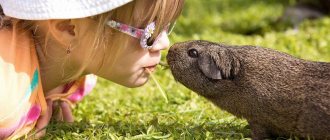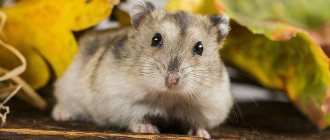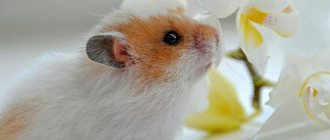- home
- Kinds
11/01/2018 The gray hamster belongs to rodents from the genus of gray hamsters. It is very similar to the field mouse, so they are often confused. The gray hamster is included in the Red Book of some regions of Russia, which attracts the attention of environmentalists.
Lifestyle
These rodents are active mainly at night, although they are also on the surface during the daytime. Their home is a burrow with many rooms for storing supplies. The cleanliness of these rodents requires the presence of a room to tidy up their fur. It has been noticed that they rarely dig holes for themselves; more often they occupy empty holes of moles and mice. They can also settle near places where agricultural harvests are stored (barns and grain warehouses). Hunting and searching for food occurs at a distance of up to 300 meters from the hole, but sometimes hamsters can go further.
Due to poor eyesight, hamsters are forced to navigate by smells and noise. With a calm nature, these small animals can show aggression towards their relatives or towards mice. Hamsters prefer to run away from danger.
During winter, gray hamsters can hibernate for up to 5 months. This habit is mainly observed in animals living in the north. Residents of the southern regions lead a less active lifestyle in cold weather.
In dry years, the number of individuals of gray hamsters is greater than in rainy years.
The gray Syrian hamster is food for birds of prey, as well as foxes, ferrets and stoats.
Description
A rodent the size of a mouse with a very short, inconspicuous tail and short legs. Has large cheek pouches. Body length 9.5-13 cm, tail 2-3.5 cm. The maximum weight of a hamster is 300 grams. The animal has an oblong muzzle, small rounded ears and a pointed nose. Black shiny eyes can be seen on the hamster's face.
It differs from voles in the short, even tail pubescence and the absence of transverse rings on it, from the Eversmann's hamster in the absence of a throat spot, from the long-tailed hamster in having single-colored ears, and from the Mongolian hamster in having a longer tail.
The color of a hamster has a camouflage function, since it can become prey for many predators. The back is smoky-gray, dark gray or brownish-gray, in some cases reddish-sandy. Darkening is sometimes observed on the head and along the ridge, but does not develop into a clear stripe. The belly is light gray or white. Paws are white. The tail is either light or faintly two-colored. The eyes are big. The ears are small and protrude slightly from the fur.
What do they eat?
The diet of these animals includes grains, seeds, plants and various representatives of invertebrate animals.
Hamsters prefer millet, barley, wheat and oats among grains. Among the seasonal foods, hamsters love watermelon, melon, squash and pumpkin seeds. Carrots, beets and corn are also included in their diet.
Among the representatives of the animal world, hamsters prefer worms, beetles, ants, mollusks and crustaceans.
Like all rodents, the gray hamster stores so much grain during the warm season that its weight exceeds the weight of the animal several times.
Conditions of detention
Gray hamsters can also be kept at home. To do this, you will need a small cage or aquarium (40/30/30 cm). These animals live well alone, so it is better to keep one or two animals of different sexes in one cage. Individuals of the same sex can conflict.
Sawdust, scraps of paper or hay would be good bedding for animals. The air temperature in the room should be 20–22 degrees. At low temperatures, hamsters can hibernate.
Often kept as pets or laboratory animals.
Pets lead an active lifestyle, so when keeping a house, they need to put a ladder and a special wheel for rodents in their cage. And be careful when opening the door, as pets may jump out.
A box with a hole for entry is suitable for arranging a nest. There the pets will be able to rest and breed. For nesting, they need to be offered pieces of fabric, cotton wool and paper.
Hamsters instinctively store food, even under established feeding patterns. Therefore, the cage needs to be regularly cleaned of perishable supplies. For example, pieces of fresh vegetables or fruits can harm your pet's health. But you can leave the grain and seeds, as they are stored for a long time, and the animal will be calmer.
Female hamsters can give birth to 2 or 3 offspring during the warm season. At one time they give birth to up to 8 cubs. Pregnancy lasts two decades. Once born, hamsters reach sexual maturity after 2–3 months, and manage to give birth to the next generation without waiting for the end of the year.
Population of the species
The territory of residence of gray hamsters extends from Greece to Altai, from the north of the forest-steppe to Iran. Despite the fairly large scale of distribution, the number of individuals is low. In Lipetsk, Tula and other regions, this species is listed in the region's Red Book. Gray hamsters are assigned category 3. This means that the species is poorly studied and has a small number.
In the wild, these animals suffer from predators, the use of chemicals in agriculture and deforestation for economic needs.
Spreading
Distributed from Eastern Europe through Russia and central Asia to Mongolia and to western China. The southern edge of its range passes through Israel, Jordan, Iraq, Iran, Afghanistan, Pakistan and northern India. At first he lived in dry meadows, steppes and semi-deserts. Now it also lives on farmland and in gardens, and sometimes even in houses. Prefers arid areas with relatively sparse vegetation, avoids forests and wet habitats.
In Russia, the gray hamster lives in the European part north to the Moscow region and the mouth of the Kama, in the Caucasus and the south of Western Siberia to the foothills of Altai in the east, in forest-steppes, steppes and populated areas. Brought to Moscow, where it took root in some areas of the city (for example, near the Belorussky railway station). It adheres to dry places, desert depressions, rocks and screes in the mountains, steppe ravines, wastelands and pastures.
What if we have a golden or striped hamster in front of us?
Signs of a male
In four-week-old males, the testicles are already visible at the very base of the tail. Stroke the animal so that it relaxes and does not struggle, and lightly press on the abdomen so that the testes (testicles) become visible. But the most important thing is distance. The distance from the penis to the anus in adult males is from 1 to 1.5 cm. And in babies it’s about 0.5 cm.
Also, in males, the navel is usually clearly palpable in the center of the abdomen - this is a gland characteristic of hamsters, with the help of which they mark their territory. It feels like a small growth.
Sometimes male Djungarian hamsters have a small congenital defect: the gonads do not descend into the scrotum, but remain in the abdominal cavity, in this case it is clear that the urethra and anus are located at a slight distance from each other.
In Djungarian babies, you can tactilely detect small swellings in the groin - these are maturing testicles.
Signs of a female
Assess the size of your pet compared to others: usually females are larger than males. But if there are no other hamsters nearby, it is worth trying a more accurate method. In female “jungarians” the distance between the genitals and the anus is much smaller than in males: approximately 3 mm, almost close.
A female can also be identified by two rows of tiny nipples that stretch from the chest to the bottom of the abdomen - there are usually eight of them, each intended for the planned calf. But the navel of females, unlike males, is almost invisible. In front of you is a female, and if upon examination you see one hole, but a large one, there may be two of them, but due to the too small size and small age of the animal, they visually merge into one.
Roborovsky's hamster
These are the smallest of the domestic hamsters. Their body length is only 4-5 cm. Since this is a breed of dwarf hamsters, they are similar in appearance to Djungarian and Campbell's hamsters. However, they do not have a stripe on their back, and their legs are slightly longer. The top of these hamsters is pinkish-fawn, the abdomen and paws are white, and there is thick fluff on the paws. This breed can also be distinguished from others by its eyebrows - small white spots above the eyes.
These are social animals, they live in pairs or entire families. Roborovsky's hamsters are independent, very fast and nimble creatures. Catching such an animal can sometimes be difficult; it won’t sit on your hands for a long time either. But this makes it even more fun and amusing.
Conditions of detention:
- cages measuring 30*50 cm, with frequently spaced bars;
- the cage must be equipped with a wheel with a treadmill for daily jogging;
- Shared accommodation is recommended.
On average, these miniature animals live 2-3 years, sometimes more.
External data
In the description, rodents of a small species reach a length of up to 12-13 cm. In nature, there are larger individuals from the family of gray hamsters, the descriptive characteristics of which indicate their size up to 25 cm in length. The average weight of an animal is up to 300 grams.
A distinctive feature is the color of their fluffy fur:
- the upper part of the rodent's body is covered with uniform fur, the shades of which vary from light tones of gray to darker tones - brown with ocher, some individuals have a coat color with shades of red,
- in the summer, some individuals have a dark stripe running along the spine in the center of the dorsal region,
- The fur on the bottom of the body is also monochromatic, but lighter in shade.
The color of the animal acts as a kind of camouflage for the animal against predators.
Decorative breeds bred in nature are Syrian and Djungarian hamsters. In appearance, the Syrian breed of rodent and the Dzungarian breed are very similar to their wild representative. Moreover, the Syrian species is the largest of the ornamental hamsters.
The gray hamster is similar in appearance to the hairy-legged representative of rodents, but differs from it in having a more elongated muzzle and smaller eyes. His ears are small and hidden in his fur. Due to the rounded shape of the ears, the rodent is sometimes mistaken for a vole. It has large cheek pouches, which is another distinctive feature.
A rodent with a dense build is very similar to an ordinary mouse.
The gray hamster has a small tail, almost imperceptible in length, up to 2.0 - 3.5 cm, but in some members of the family it can be longer than the body itself. Sometimes he is completely bald or covered with a small amount of sparse wool fibers. The soles of the rodent's paws are covered with thin hair.
Life style of an ordinary animal
The common hamster (Cricetus Cricetus) leads a fairly varied lifestyle. Its lifespan of 8 years allows it to live 2-3 times longer than its domestic counterparts. Thanks to its agility, activity and, of course, claws, the animal digs holes up to 8 meters. And this is not just a pit, it is a network of tunnels that have different chambers and serve for various purposes. There can be up to 10 exits from the hole itself, from this you can see how careful the hamster is. Leaves many escape routes in case of danger.
From August he begins to actively work on food and replenish supplies for the winter. One or more chambers in the burrow serve as a storage room where all collected food is stored. At such a depth, predators cannot reach it. Even severe frosts are not able to reach the hamster and its supplies. And he lives very well in the hole; there is always bedding, which he makes for himself to make it warmer. The depth of the hole rarely exceeds 2.5 meters. With the onset of winter, the common hamster goes into hibernation. From time to time he wakes up for a meal, it’s not in vain that so much time and effort was spent collecting such treasures.
Like other species, our hero is a loner and does not allow competitors into his territory. When uninvited guests invade, there will definitely be a fight between the hamsters (unless, of course, the enemy immediately leaves). Someone must retreat or die. Two hamsters do not get along in the same territory. During the breeding season, they come together only to mate, after which they again live a solitary life. The animal can attack not only its fellow animals, but also a person. An interesting fact about the hamster is that it is not afraid of larger opponents. Therefore, he is able to bite people and fight back. But there is also control over it; a rodent can become prey for a fox or ferret.
When the animal is ready to attack, it stands like a man on two hind legs, the front legs at chest level and slightly spread to the sides. At this time, he can jump into the attack, which he usually does. But after the jump, he returns to his stance to prepare for the next attack. Despite the fact that the animal runs and jumps quickly, in a calm state it moves rather slowly. Photos of the common hamster during the daytime are posted on the Internet, but these are rather exceptions, since these are nocturnal animals and they sleep during the day.
Syrian hamster
These hamsters are also called golden hamsters because of their distinctive coat color.
These are quite large hamsters: their body length can reach 13-19 cm, and their weight is approximately 100-200 grams. Their muzzle is small and short, their eyes are black, their ears are gray, their tail is small, and their belly is ivory-colored. Syrian hamsters come in long-haired and short-haired varieties. On the front paws, in addition to 4 fingers, the Syrian hamster has a vestige of a 5th toe, so it can hold treats in them. And on the hind legs there are 5 fingers, thanks to which the animal can, by clinging to the bars of the cage, keep its body suspended. All this makes watching the animal even more interesting. He loves to run and can run up to 7 km per night.
The most common coat color is golden, but there are also individuals with a coat of cream and sand colors.
This type of hamster is perfect for keeping at home. Golden hamsters are very nimble and active, they like communication and games with their owners. They are clean and love their home to be orderly and clean. If the Syrian hamster is provided with good nutrition and care, it will please its owners with its health - this breed is less susceptible to various infections.
By nature, these are solitary animals: they meet with a female only during the breeding season. Therefore, the Syrian hamster must be placed in a separate cage.
Conditions of detention:
- cage size 40*60 cm;
- the cage must have a jogging wheel with a diameter of at least 18 cm with a continuous running surface;
- single occupancy.
The life expectancy of these animals in captivity is 2-3 years.




